Phubbing Behaviour: A Bibliometric Analysis of Scientific Production †
Abstract
1. Introduction
- (1)
- What are the most influential documents, authors, sources, countries, and organisations?
- (2)
- Which are the most used keywords, and how do they perform?
- (3)
- What is the citation pattern in the literature?
2. Literature Review
2.1. Phubbing Behavior: Explanatory Theories
2.2. Contexts Where Phubbing Occurs
2.3. Effects of Phubbing
2.4. Determinants of Phubbing
3. Empirical Study
3.1. Data
3.2. Descriptive Analysis
3.3. Bibliometric Tool
4. Results of the Analysis
4.1. Relevance of Documents, Authors, Sources, Countries and Organisations
4.2. Co-Occurrence Network Analysis
4.3. Co-Citation Analysis
5. Discussion and Conclusions
5.1. Implications for Researchers: Future Research
5.2. Implications for the Prevention of Phubbing
5.3. Limitations and Contributions of the Study
5.4. Conclusions
Author Contributions
Funding
Institutional Review Board Statement
Informed Consent Statement
Data Availability Statement
Conflicts of Interest
References
- Abi Doumit, C., Malaeb, D., Akel, M., Salameh, P., Obeid, S., & Hallit, S. (2023). Association between personality traits and phubbing: The co-moderating roles of boredom and loneliness. Healthcare, 11(6), 915. [Google Scholar] [CrossRef] [PubMed]
- Afdal, A., Alizamar, A., Ifdil, I., Ardi, Z., Sukmawati, I., Zikra, Z., Ilyas, A., Fikri, M., Syahputra, Y., & Hariyani, H. (2019). An analysis of phubbing behaviour: Preliminary research from counseling perspective. Advances in Social Science, Education and Humanities Research, 295, 270–273. [Google Scholar] [CrossRef]
- Aljasir, S. (2022). Present but absent in the digital age: Testing a conceptual model of phubbing and relationship satisfaction among married couples. Human Behavior and Emerging Technologies, 2022, 1402751. [Google Scholar] [CrossRef]
- Al-Saggaf, Y. (2021). Phubbing, fear of missing out and boredom. Journal of Technology in Behavioral Science, 6(2), 352–357. [Google Scholar] [CrossRef]
- Al-Saggaf, Y., & O’Donnell, S. B. (2019). Phubbing: Perceptions, reasons behind, predictors, and impacts. Human Behavior and Emerging Technologies, 1(2), 132–140. [Google Scholar] [CrossRef]
- Archambault, É., Vignola-Gagné, É., Côté, G., Larivière, V., & Gingrasb, Y. (2006). Benchmarking scientific output in the social sciences and humanities: The limits of existing databases. Scientometrics, 68(3), 329–342. [Google Scholar] [CrossRef]
- Ayar, D., & Gürkan, K. P. (2022). The effect of nursing students’ smartphone addiction and phubbing behaviors on communication skill. CIN: Computers, Informatics, Nursing, 40(4), 230–235. [Google Scholar] [CrossRef]
- Balta, S., Emirtekin, E., Kircaburun, K., & Griffiths, M. D. (2020). Neuroticism, trait fear of missing out, and phubbing: The mediating role of state fear of missing out and problematic instagram use. International Journal of Mental Health and Addiction, 18(3), 628–639. [Google Scholar] [CrossRef]
- Bevilacqua, M., Ciarapica, F. E., & Marcucci, G. (2019). Supply chain resilience research trends: A literature overview. IFAC-PapersOnLine, 52(13), 2821–2826. [Google Scholar] [CrossRef]
- Blanca, M. J., & Bendayan, R. (2018). Spanish version of the phubbing scale: Internet addiction, facebook intrusion, and fear of missing out as correlates. Psicothema, 30(4), 449–454. [Google Scholar] [CrossRef]
- Braune-Krickau, K., Schneebeli, L., Pehike-Milde, J., Gemperle, M., Koch, R., & von Wyl, A. (2021). Smartphones in the nursery: Parental smartphone use and parental sensitivity and responsiveness within parent-child interaction in early childhood (0–5 years): A scoping review. Infant Mental Health Journal, 42, 161–175. [Google Scholar] [CrossRef] [PubMed]
- Callon, M., Courtial, J.-P., Turner, W. A., & Bauin, S. (1983). From translations to problematic networks: An introduction to co-word analysis. Social Science Information, 22(2), 191–235. [Google Scholar] [CrossRef]
- Capilla Garrido, E., Issa, T., Gutiérrez Esteban, P., & Cubo Delgado, S. (2021). A descriptive literature review of phubbing behaviors. Heliyon, 7(5), e07037. [Google Scholar] [CrossRef]
- Cebollero-Salinas, A., Bautista Alcaine, P., Iñiguez-Berrozpe, T., & Elboj Saso, C. (2022a). Would you mind paying attention to me? Phubbing in adolescence as an Educational challenge in digital and face to face coexistence. Revista Complutense de Educación, 33(4), 601–610. [Google Scholar] [CrossRef]
- Cebollero-Salinas, A., Cano Escoriaza, J., & Orejudo Hernández, S. (2021). Abuso de Internet y adolescentes: Gratificaciones, supervisión familiar y uso responsable. Implicaciones educativas y familiares. Digital Education Review, 39(39), 42–59. [Google Scholar] [CrossRef]
- Cebollero-Salinas, A., Cano-Escoriaza, J., Orejudo Hernández, S., & Iñiguez-Berrrozpe, T. (2022b). Netiquette, implication of online emotional content and empathy in adolescents according to gender. Revista Latinoamericana de Psicología, 54, 104–111. [Google Scholar] [CrossRef]
- Cebollero-Salinas, A., Elboj-Saso, C., Iñiguez-Berrozpe, T., & Bautista-Alcaine, P. (2024a). Confronting fake news through collective intelligence in adolescents. International Journal of Human-Computer Interaction, 1–14. [Google Scholar] [CrossRef]
- Cebollero-Salinas, A., Orejudo-Hernández, S., & Cano-Escoriaza, J. (2024b). Cybergossip in adolescence: Its relationship with social competency, empathy, emotions in online communication and socio-emotional e-competencies by gender and age. Cyberpsychology: Journal of Psychosocial Research on Cyberspace, 18(2). [Google Scholar] [CrossRef]
- Chi, L.-C., Tang, T.-C., & Tang, E. (2021). The phubbing phenomenon: A cross-sectional study on the relationships among social media addiction, fear of missing out, personality traits, and phubbing behavior. Current Psychology, 41, 1112–1123. [Google Scholar] [CrossRef]
- Chotpitayasunondh, V., & Douglas, K. M. (2016). How “phubbing” becomes the norm: The antecedents and consequences of snubbing via smartphone. Computers in Human Behavior, 63, 9–18. [Google Scholar] [CrossRef]
- Chotpitayasunondh, V., & Douglas, K. M. (2018). The effects of “phubbing” on social interaction. Journal of Applied Social Psychology, 48(6), 304–316. [Google Scholar] [CrossRef]
- Chu, X., Ji, S., Wang, X., Yu, J., Chen, Y., & Lei, L. (2021). Peer phubbing and social networking site addiction: The mediating role of social anxiety and the moderating role of family financial difficulty. Frontiers in Psychology, 12, 670065. [Google Scholar] [CrossRef] [PubMed]
- Clarivate Analytics. (2022). Web of science platform. Available online: https://clarivate.com/academia-government/scientific-and-academic-research/research-discovery-and-referencing/web-of-science/ (accessed on 24 November 2022).
- Davey, S., Davey, A., Raghav, S. K., Singh, J. V., Singh, N., Blachnio, A., & Przepiórkaa, A. (2018). Predictors and consequences of “Phubbing” among adolescents and youth in India: An impact evaluation study. Journal of Family and Community Medicine, 25(1), 35–42. [Google Scholar] [CrossRef]
- Denecker, F., De Marez, L., Ponnet, K., & Vanden Abeele, M. (2023). Does parental smartphone use predict parents’ perceptions of family life? An examination of momentary associations between parental smartphone use, parental experiences of quality time, and parental perceptions of difficult child behavior. Mobile Media & Communication, 11(3), 391–414. [Google Scholar] [CrossRef]
- Dikere, B., & Turkasian, K. L. (2024). Partner phubbing and sleep quality: Serial mediation models with relationship satisfaction and perceived stress. Psychological Reports, 25, 332941241283759. [Google Scholar] [CrossRef] [PubMed]
- Dontre, A. J. (2021). The influence of technology on academic distraction: A review. Human Behavior and Emerging Technologies, 3(3), 379–390. [Google Scholar] [CrossRef]
- Downe-Wamboldt, B. (1992). Content analysis: Method, applications, and issues. Health Care for Women International, 13(3), 313–321. [Google Scholar] [CrossRef]
- Elboj, C., Íñiguez-Berrozpe, T., Cebollero-Salinas, A., & Bautista-Alcaine, P. (2023). “Listen to me!” The role of family supervision and parental phubbing in youth cyberbullying. Family Relations, 73(3), 1568–1587. [Google Scholar] [CrossRef]
- Erzen, E., Odaci, H., & Yeniçeri, İ. (2021). Phubbing: Which personality traits are prone to phubbing? Social Science Computer Review, 39(1), 56–69. [Google Scholar] [CrossRef]
- Falcão, D., & Roseira, C. (2022). Mapping the socially responsible consumption gap research: Review and future research agenda. International Journal of Consumer Studies, 46, 1718–1760. [Google Scholar] [CrossRef]
- Fernández-Andújar, M., Alonso, M. O., Sorribes, E., Villalba, V., & Calderon, C. (2022). Internet addiction, phubbing, psychological variables and self-perception of mathematical competence in college students. Mathematics, 10(15), 2631. [Google Scholar] [CrossRef]
- Frackowiak, M., Hilpert, P., & Russell, P. S. (2022). Partner’s perception of phubbing is more relevant than the behavior itself: A daily diary study. Computers in Human Behavior, 134, 197323. [Google Scholar] [CrossRef]
- Gaeta-González, M. L., Hernández, S. O., & Cebollero-Salinas, A. (2025). FoMO and socioemotional e—Competencies as predictors of media multitasking, phubbing and cybergossip in university students: Transnational differences between Mexico and Spain by gender. Journal of Community Psychology, 53(2), e23183. [Google Scholar] [CrossRef]
- Gao, B., Shen, Q., Luo, G., & Xu, Y. (2023). Why mobile social media-related fear of missing out promotes depressive symptoms? The roles of phubbing and social exclusion. BMC Psychology, 11(1), 189. [Google Scholar] [CrossRef] [PubMed]
- Guerra Ayala, M. J., Alegre de la Rosa, O. M., Chambi Catacora, M., Vargas Onofre, E., Cari, C., & Díaz Flores, D. (2025). Nomophobia, phubbing, and deficient sleep patterns in college students. Frontiers in Education, 9, 1421162. [Google Scholar] [CrossRef]
- Gutiérrez-Nieto, B., Ortiz, C., & Vicente, L. (2023). A bibliometric analysis of the disposition effect: Origins and future research avenues. Journal of Behavioral and Experimental Finance, 37, 100774. [Google Scholar] [CrossRef]
- Halpern, D., & Katz, J. E. (2017). Texting’s consequences for romantic relationships: A cross-lagged analysis highlights its risks. Computers in Human Behavior, 71, 386–394. [Google Scholar] [CrossRef]
- Hao, L., Liu, D., Yin, J., Lin, B., Zhang, X., & Jiang, Q. (2021). Peer phubbing and selfie liking: The roles of attention seeking and gender. Social Behavior and Personality, 49(7), e10468. [Google Scholar] [CrossRef]
- Jabeen, F., Tandon, A., Sithipolvanichgul, J., Srivastava, S., & Dhir, A. (2023). Social media-induced fear of missing out (FoMO) and social media fatigue: The role of narcissism, comparison and disclosure. Journal of Business Research, 159, 113693. [Google Scholar] [CrossRef]
- Karadaǧ, E., Tosuntaş, Ş. B., Erzen, E., Duru, P., Bostan, N., Şahin, B. M., Çulha, I., & Babadaǧ, B. (2015). Determinants of phubbing, which is the sum of many virtual addictions: A structural equation model. Journal of Behavioral Addictions, 4(2), 60–74. [Google Scholar] [CrossRef]
- Kardefelt-Winther, D. (2014). A conceptual and methodological critique of internet addiction research: Towards a model of compensatory internet use. Computers in Human Behavior, 31, 351–354. [Google Scholar] [CrossRef]
- Khan, M. N., Shahzad, K., & Bartels, J. (2022). Examining boss phubbing and employee outcomes through the lens of affective events theory. Aslib Journal of Information Management, 74(5), 877–900. [Google Scholar] [CrossRef]
- Knausenberger, J., Giesen-Leuchter, A., & Echterhoff, G. (2022). Feeling ostracized by others’ smartphone use: The effect of phubbing on fundamental needs, mood, and trust. Frontiers in Psychology, 13, 883901. [Google Scholar] [CrossRef] [PubMed]
- Koc, T., & Caliskan, K. (2022). Phubbing phenomenon in educational environments: Examining the impact of supervisor phubbing on student outcomes. Journal of Further and Higher Education, 47(1), 15–30. [Google Scholar] [CrossRef]
- Konrad, C., Hillmann, M., Rispler, J., Niehaus, L., Neuhoff, L., & Barr, R. (2021). Quality of mother-child interaction before, during, and after smartphone use. Frontiers in Psychology, 12, 616656. [Google Scholar] [CrossRef]
- Lai, X., Hu, C., Ying, L., Xu, H., Zhao, C., Yang, X., Yu, X., & Zhang, G. (2022). Risk and protective factors associated with smartphone addiction and phubbing behavior among college students in China. Psychological Reports, 126(5), 2172–2190. [Google Scholar] [CrossRef]
- Lemish, D., Elias, N., & Floegel, D. (2020). “Look at me!” Parental use of mobile phones at the playground. Mobile Media and Communication, 8(2), 170–187. [Google Scholar] [CrossRef]
- Liu, W. (2019). The data source of this study is Web of Science core collection? Not enough. Scientometrics, 121(3), 1815–1824. [Google Scholar] [CrossRef]
- Mackay, L. J., Komanchuk, J., Hayden, K. A., & Letourneau, N. (2022). Impacts of parental technoference on parent-child relationships and child health and developmental outcomes: A scoping review protocol. Systematic Reviews, 11(1), 1–8. [Google Scholar] [CrossRef]
- McDaniel, B. T. (2019). Parent distraction with phones, reasons for use, and impacts on parenting and child outcomes: A review of the emerging research. Human Behavior and Emerging Technologies, 1(2), 72–80. [Google Scholar] [CrossRef]
- McDaniel, B. T., & Coyne, S. M. (2016). “Technoference”: The interference of technology in couple relationships and implications for women’s personal and relational well-being. Psychology of Popular Media Culture, 5(1), 85–98. [Google Scholar] [CrossRef]
- McDaniel, B. T., & Drouin, M. (2019). Daily technology interruptions and emotional and relational well-being. Computers in Human Behavior, 99, 1–8. [Google Scholar] [CrossRef] [PubMed]
- McDaniel, B. T., Galovan, A. M., Cravens, J. D., & Drouin, M. (2018). “Technoference” and implications for mothers’ and fathers’ couple and coparenting relationship quality. Computers in Human Behavior, 80, 303–313. [Google Scholar] [CrossRef] [PubMed]
- Melega, A. (2025). Geopolitical risks in financial reporting and transfer pricing. Springer Science and Business Media LLC. [Google Scholar]
- Moral-Muñoz, J. A., Herrera-Viedma, E., Santisteban-Espejo, A., & Cobo, M. J. (2020). Software tools for conducting bibliometric analysis in science: An up-to-date review. El Profesional de La Información, 29(1), e290103. [Google Scholar] [CrossRef]
- Nuñez, T. R., & Radtke, T. (2023). Is socially disruptive smartphone use detrimental to well-being? A systematic meta-analytic review on being phubbed. Behaviour & Information Technology, 43(7), 1283–1311. [Google Scholar] [CrossRef]
- Nuñez, T. R., Radtke, T., & Eimler, S. C. (2020). A third-person perspective on phubbing: Observing smartphone-induced social exclusion generates negative affect, stress, and derogatory attitudes. Cyberpsychology: Journal of Psychosocial Research on Cyberspace, 14(3), 3. [Google Scholar] [CrossRef]
- Orejudo, S., Cano-Escoriaza, J., Cebollero-Salinas, A., Bautista, P., Clemente-Gallardo, J., Rivero, A., Rivero, P., & Tarancón, A. (2022). Evolutionary emergence of collective intelligence in large groups of students. Frontiers in Psychology, 13, 848048. [Google Scholar] [CrossRef]
- Perianes-Rodriguez, A., Waltman, L., & van Eck, N. J. (2016). Constructing bibliometric networks: A comparison between full and fractional counting. Journal of Informetrics, 10(4), 1178–1195. [Google Scholar] [CrossRef]
- Pritchard, A. (1969). Statistical bibliography or bibliometrics. Journal of Documentation, 25(4), 344–349. [Google Scholar] [CrossRef]
- Qu, J., Lei, L., Wang, X., Xie, X., & Wang, P. (2022). Mother phubbing and adolescent cyberbullying: The mediating role of perceived mother acceptance and the moderating role of emotional stability. Journal of Interpersonal Violence, 37(11–12), 9591–9612. [Google Scholar] [CrossRef]
- Roberts, J. A., & David, M. E. (2016). My life has become a major distraction from my cell phone: Partner phubbing and relationship satisfaction among romantic partners. Computers in Human Behavior, 54, 134–141. [Google Scholar] [CrossRef]
- Roberts, J. A., & David, M. E. (2017). Put down your phone and listen to me: How boss phubbing undermines the psychological conditions necessary for employee engagement. Computers in Human Behavior, 75, 206–217. [Google Scholar] [CrossRef]
- Roberts, J. A., & David, M. E. (2022). Partner phubbing and relationship satisfaction through the lens of social allergy theory. Personality and Individual Differences, 195, 111676. [Google Scholar] [CrossRef]
- Ruggiero, T. E. (2000). Uses and gratifications theory in the 21st century. Mass Communication and Society, 3(1), 3–37. [Google Scholar] [CrossRef]
- Schokkenbroek, J. M., Hardyns, W., & Ponnet, K. (2022). Phubbed and curious: The relation between partner phubbing and electronic partner surveillance. Computers in Human Behavior, 137, 107425. [Google Scholar] [CrossRef]
- Shao, T., Zhu, C., Quan, X., Wang, H., & Zhang, C. (2022). The relationship of technoference in conjugal interactions and child smartphone dependence: The chain mediation between marital conflict and coparenting. International Journal of Environmental Research and Public Health, 19(17), 10949. [Google Scholar] [CrossRef]
- Small, H. (1973). Co-citation in the scientific literature: A new measure of the relationship between two documents. Journal of the American Society for Information Science, 24(4), 265–269. [Google Scholar] [CrossRef]
- Spatti, A. C., Capanema Bezerra, L., Fredo, E., Bin, A., Paulino, J., CHiorato, A., Morais, S., & Gomes Correia, G. (2022). A century of common bean: Bibliometrics and scientific production. Cuadernos de Ciencia &Tecnologia, 39(1), 1–12. [Google Scholar] [CrossRef]
- Stevic, A., & Matthes, J. (2023). Co-present smartphone use, friendship satisfaction, and social isolation: The role of coping strategies. Computers in Human Behavior, 149, 107960. [Google Scholar] [CrossRef]
- Stockdale, L. A., Coyne, S. M., & Padilla-Walker, L. M. (2018). Parent and child technoference and socioemotional behavioral outcomes: A nationally representative study of 10- to 20-year-Old adolescents. Computers in Human Behavior, 88, 219–226. [Google Scholar] [CrossRef]
- Sundqvist, A., Heimann, M., & Koch, F. S. (2020). Relationship between family technoference and behavior problems in children aged 4–5 years. Cyberpsychology, Behavior, and Social Networking, 23(6), 371–376. [Google Scholar] [CrossRef]
- Tacca Huamán, D. R., Cuarez Cordero, R., & Tacca Huamán, A. L. (2021). Phubbing, family atmosphere and self-esteem in Peruvian teenagers in the context of social isolation. International and Multidisciplinary Journal of Social Sciences, 10(3), 1–21. [Google Scholar] [CrossRef]
- Talan, T., Doğan, Y., & Kalinkara, Y. (2023). effects of smartphone addiction, social media addiction and fear of missing out on university students’ phubbing: A structural equation model. Deviant Behavior, 45(1), 1–14. [Google Scholar] [CrossRef]
- Tammisalo, K., & Rotkirch, A. (2022). Effects of information and communication technology on the quality of family relationships: A systematic review. Journal of Social and Personal Relationships, 39(9), 2724–2765. [Google Scholar] [CrossRef]
- Tandon, A., Dhir, A., Talwar, S., Kaur, P., & Mäntymäki, M. (2022). Social media induced fear of missing out (FoMO) and phubbing: Behavioural, relational and psychological outcomes. Technological Forecasting and Social Change, 174, 121149. [Google Scholar] [CrossRef]
- Tanhan, F., Özok, H. İ., Kaya, A., & Yıldırım, M. (2023). Mediating and moderating effects of cognitive flexibility in the relationship between social media addiction and phubbing. Current Psychology, 43, 192–203. [Google Scholar] [CrossRef]
- Thomas, T. T., Carnelley, K. B., & Hart, C. M. (2022). Phubbing in romantic relationships and retaliation: A daily diary study. Computers in Human Behavior, 137, 107398. [Google Scholar] [CrossRef]
- T’ng, S. T., Ho, K. H., & Low, S. K. (2018). Are you “phubbing” me? The determinants of phubbing behavior and assessment of measurement invariance across sex differences. International and Multidisciplinary Journal of Social Sciences, 7(2), 159. [Google Scholar] [CrossRef]
- Tomczyk, Ł., & Lizde, E. S. (2022). Nomophobia and phubbing: Wellbeing and new media education in the family among adolescents in Bosnia and Herzegovina. Children and Youth Services Review, 137, 106489. [Google Scholar] [CrossRef]
- Türkeli, S., Kemp, R., Huang, B., Bleischwitz, R., & McDowall, W. (2018). Circular economy scientific knowledge in the European Union and China: A bibliometric, network and survey analysis (2006–2016). Journal of Cleaner Production, 197(49), 1244–1261. [Google Scholar] [CrossRef]
- Vanden Abeele, M. M. P., Abels, M., & Hendrickson, A. T. (2020). Are parents less responsive to young children when they are on their Phones? A systematic naturalistic observation study. Cyberpsychology, Behavior, and Social Networking, 23(6), 363–370. [Google Scholar] [CrossRef]
- Vanden Abeele, M. M. P., Antheunis, M. L., & Schouten, A. P. (2016). The effect of mobile messaging during a conversation on impression formation and interaction quality. Computers in Human Behavior, 62, 562–569. [Google Scholar] [CrossRef]
- Vanden Abeele, M. M. P., Hendrickson, A. T., Pollmann, M. M. H., & Ling, R. (2019). Phubbing behavior in conversations and its relation to perceived conversation intimacy and distraction: An exploratory observation study. Computers in Human Behavior, 100, 35–47. [Google Scholar] [CrossRef]
- Vanden Abeele, M. M. P., & Postma-Nilsenova, M. (2018). More than just gaze: An experimental vignette study examining how phone-gazing and newspaper-gazing and phubbing-while-speaking and phubbing-while-listening compare in their effect on affiliation. Communication Research Reports, 35(4), 303–313. [Google Scholar] [CrossRef]
- van der Schyff, K., Renaud, K., Townes, J. P., & Tshiqi, N. (2022). Investigating the mediating effects of phubbing on self-presentation and FoMO within the context of excessive Instagram use. Cogent Psychology, 9(1). [Google Scholar] [CrossRef]
- van Eck, N. J., & Waltman, L. (2010). Software survey: VOSviewer, a computer program for bibliometric mapping. Scientometrics, 84(2), 523–538. [Google Scholar] [CrossRef] [PubMed]
- van Eck, N. J., & Waltman, L. (2017). Citation-based clustering of publications using CitNetExplorer and VOSviewer. Scientometrics, 111(2), 1053–1070. [Google Scholar] [CrossRef]
- van Eck, N. J., & Waltman, L. (2022). VOSviewer manual. Manual for VOSviewer (Version 1.6.18). Universiteit Leiden. [Google Scholar]
- Vaterlaus, J. M., Stinson, R., & McEwen, M. (2020). Technology use in young adult marital relationships: A case study approach. Contemporary Family Therapy, 42(4), 394–407. [Google Scholar] [CrossRef]
- Wang, X., Gao, L., Yang, J., Zhao, F., & Wang, P. (2020). Parental phubbing and adolescents’ depressive symptoms: Self-Esteem and perceived social support as moderators. Journal of Youth and Adolescence, 49(2), 427–437. [Google Scholar] [CrossRef]
- Wang, X., Qiao, Y., & Wang, S. (2023). Parental phubbing, problematic smartphone use, and adolescents’ learning burnout: A cross-lagged panel analysis. Journal of Affective Disorders, 320(92), 442–449. [Google Scholar] [CrossRef]
- Wang, X., Xie, X., Wang, Y., Wang, P., & Lei, L. (2017). Partner phubbing and depression among married Chinese adults: The roles of relationship satisfaction and relationship length. Personality and Individual Differences, 110, 12–17. [Google Scholar] [CrossRef]
- Wang, Z., Jiang, C., & Dai, H. (2025). Internet gaming addiction or online social networking addiction? Evidence from Chinese adolescents facing parental phubbing. International Journal Mental Health and Addiction. [Google Scholar] [CrossRef]
- Wu, Y., & Yang, X. (2021). Relative deprivation and phubbing: Fear of missing out as a mediator. Social Behavior and Personality: An International Journal, 49(7), 1–9. [Google Scholar] [CrossRef]
- Xie, X., Chen, W., Zhu, X., & He, D. (2019). Parents’ phubbing increases adolescents’ mobile phone addiction: Roles of parent-child attachment, deviant peers, and gender. Children and Youth Services Review, 105, 104426. [Google Scholar] [CrossRef]
- Xu, C., & Xie, X. (2023). Put down the phone and accompany me: How parental phubbing undermines prosocial behavior of early adolescents. Children and Youth Services Review, 149, 106958. [Google Scholar] [CrossRef]
- Xu, T., Wang, T., & Duan, J. (2022). Leader phubbing and employee job performance: The effect of need for social approval. Psychology Research and Behavior Management, 15, 2303–2314. [Google Scholar] [CrossRef]
- Xu, X. P., Liu, Q. Q., Li, Z. H., & Yang, W. X. (2022). The mediating role of loneliness and the moderating role of gender between peer phubbing and adolescent mobile social media addiction. International Journal of Environmental Research and Public Health, 19(16), 10176. [Google Scholar] [CrossRef]
- Yang, W., Tang, L., Shen, X., Niu, G., Shi, X., Jin, S., Zhang, Y., & Yuan, Z. (2023). Parental phubbing and adolescent depressive symptoms during COVID-19: A serial meditating model. Behavioral Sciences, 13(5), 371. [Google Scholar] [CrossRef]
- Yasin, R. M., Bashir, S., Abeele, M. V., & Bartels, J. (2023). Supervisor phubbing phenomenon in organizations: Determinants and impacts. International Journal of Business Communication, 60(1), 150–172. [Google Scholar] [CrossRef]
- Zhang, Y., Ding, Q., & Wang, Z. (2021). Why parental phubbing is at risk for adolescent mobile phone addiction: A serial mediating model. Children and Youth Services Review, 121, 105873. [Google Scholar] [CrossRef]
- Zhao, J., Ye, B., & Yu, L. (2021). Peer phubbing and Chinese college students’ smartphone addiction during covid-19 pandemic: The mediating role of boredom proneness and the moderating role of refusal self-efficacy. Psychology Research and Behavior Management, 14, 1725–1736. [Google Scholar] [CrossRef] [PubMed]
- Zimmerle, J. C. (2019). Limiting technoference: Healthy screen time habits for new parents. International Journal of Childbirth Education, 34(2), 54–59. [Google Scholar]
- Zott, C., Amit, R., & Massa, L. (2011). The business model: Recent developments and future research. Journal of Management, 37(4), 1019–1042. [Google Scholar] [CrossRef]
- Zupic, I., & Čater, T. (2015). Bibliometric methods in management and organization. Organizational Research Methods, 18(3), 429–472. [Google Scholar] [CrossRef]
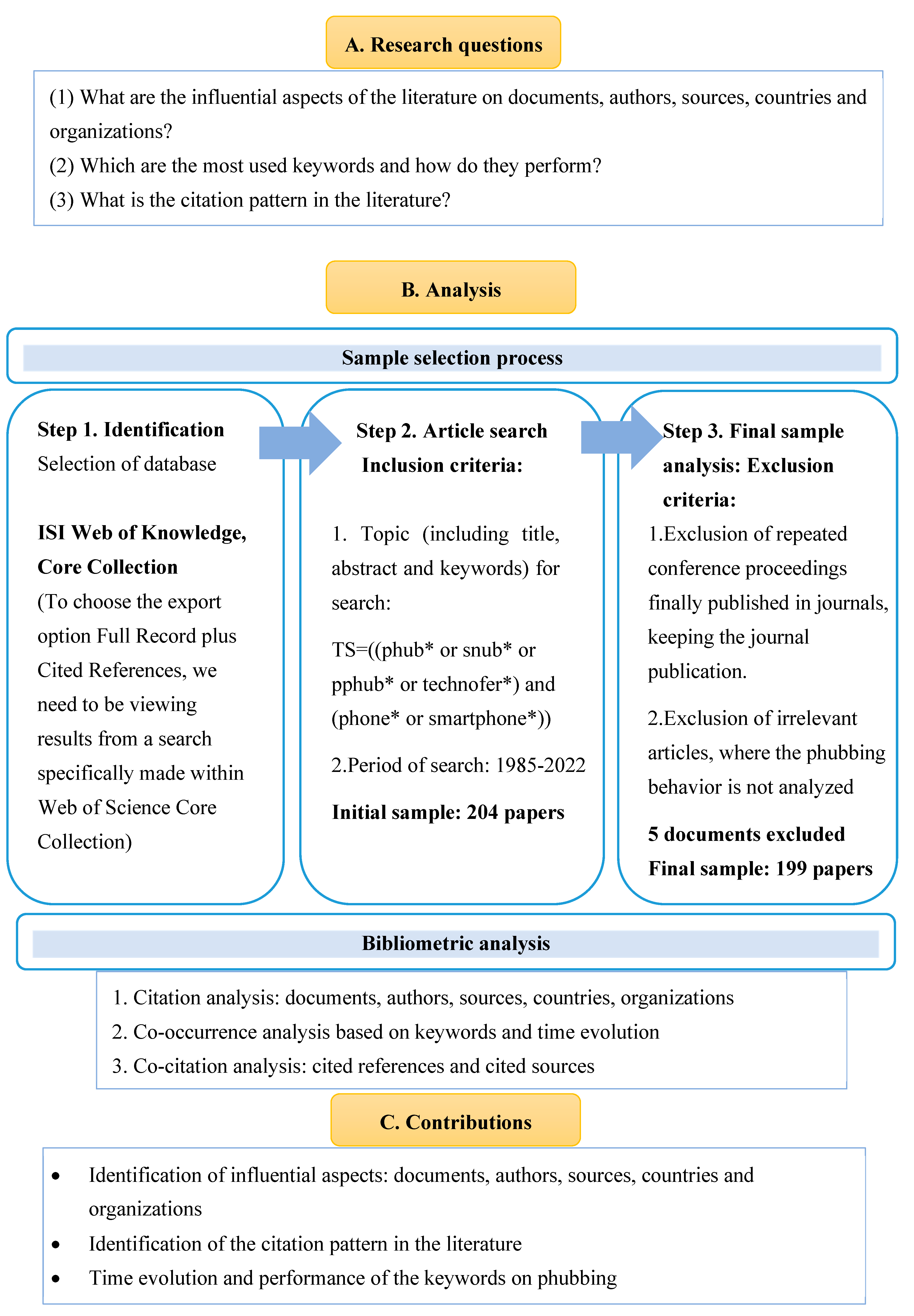
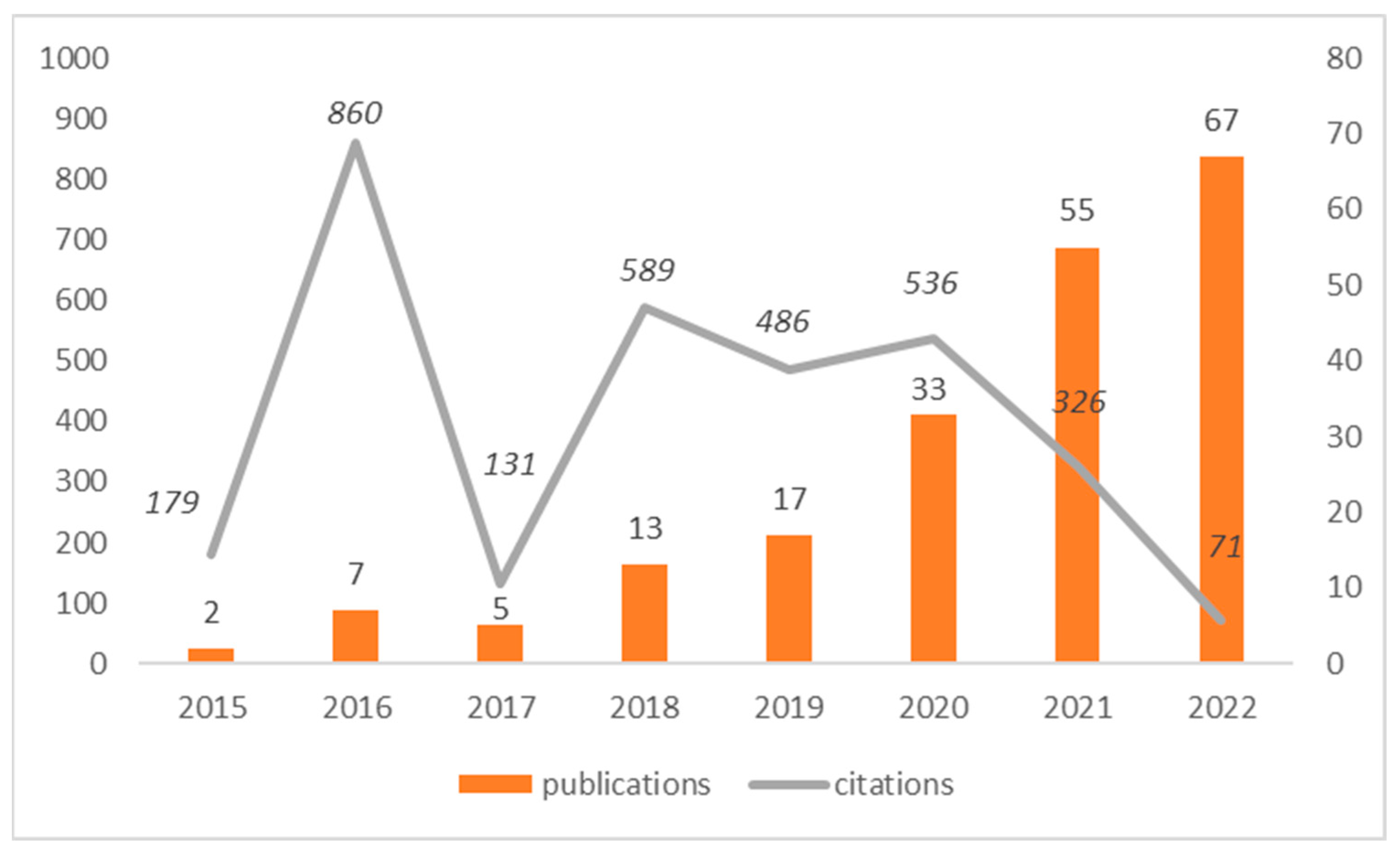
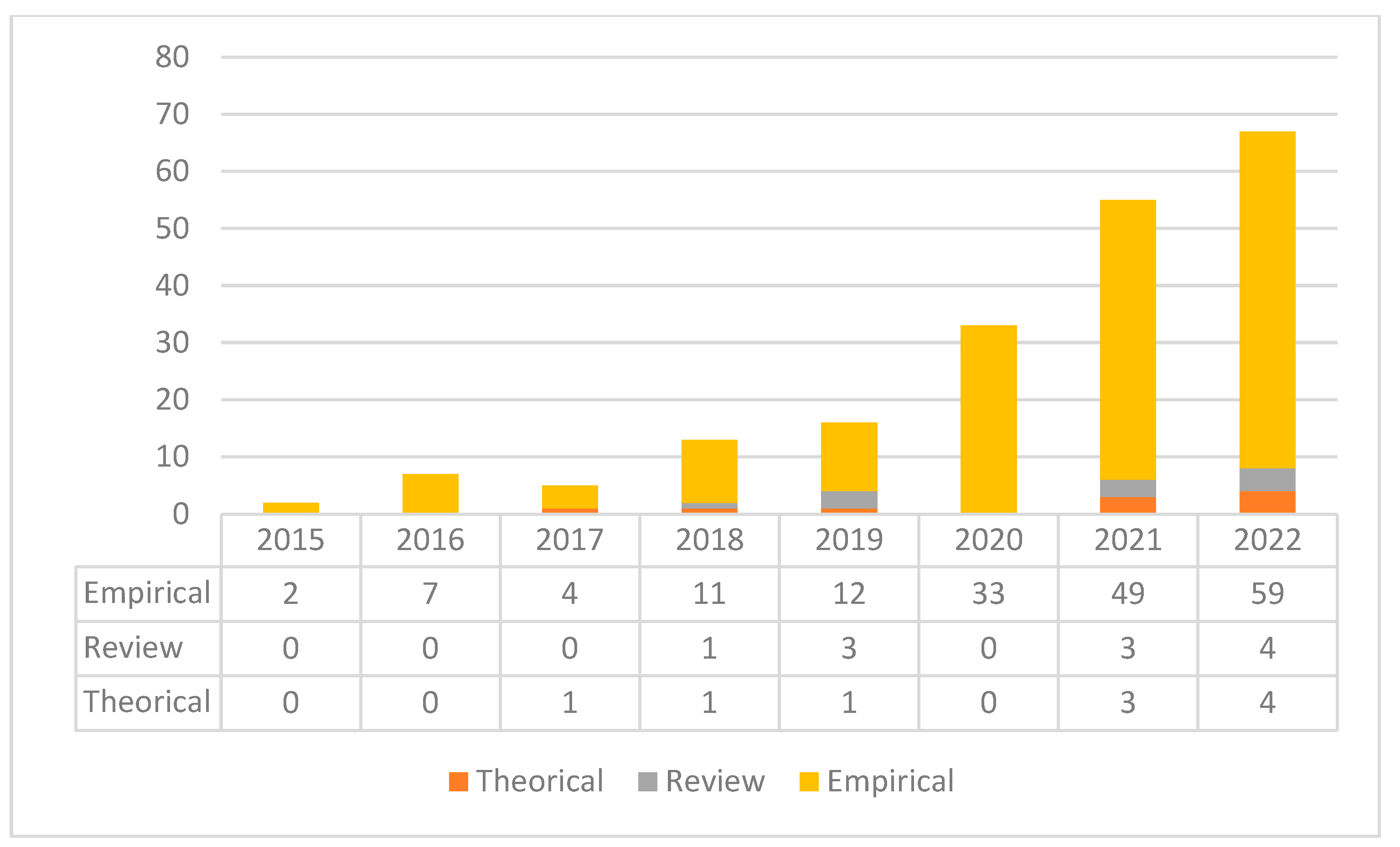
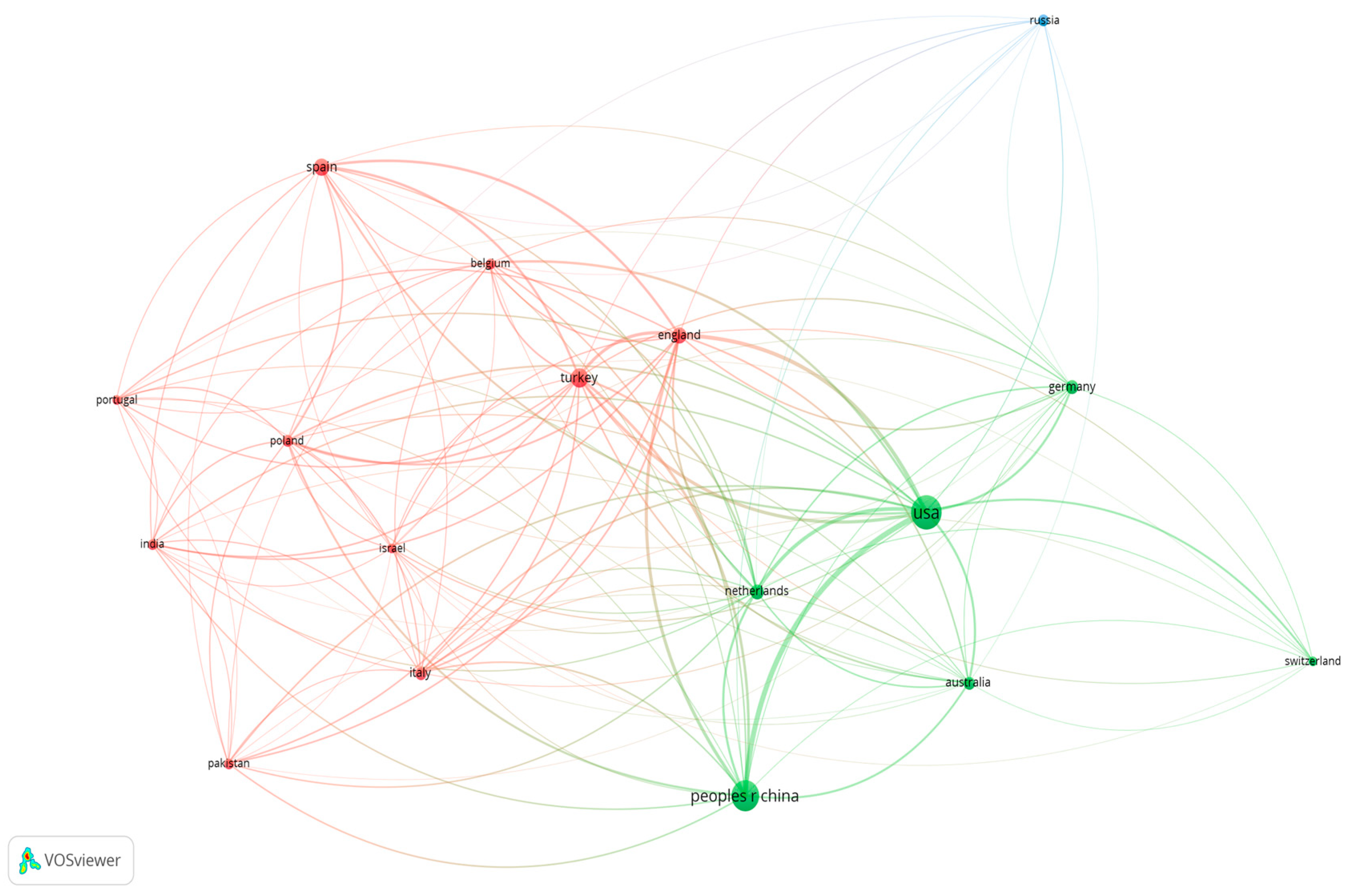
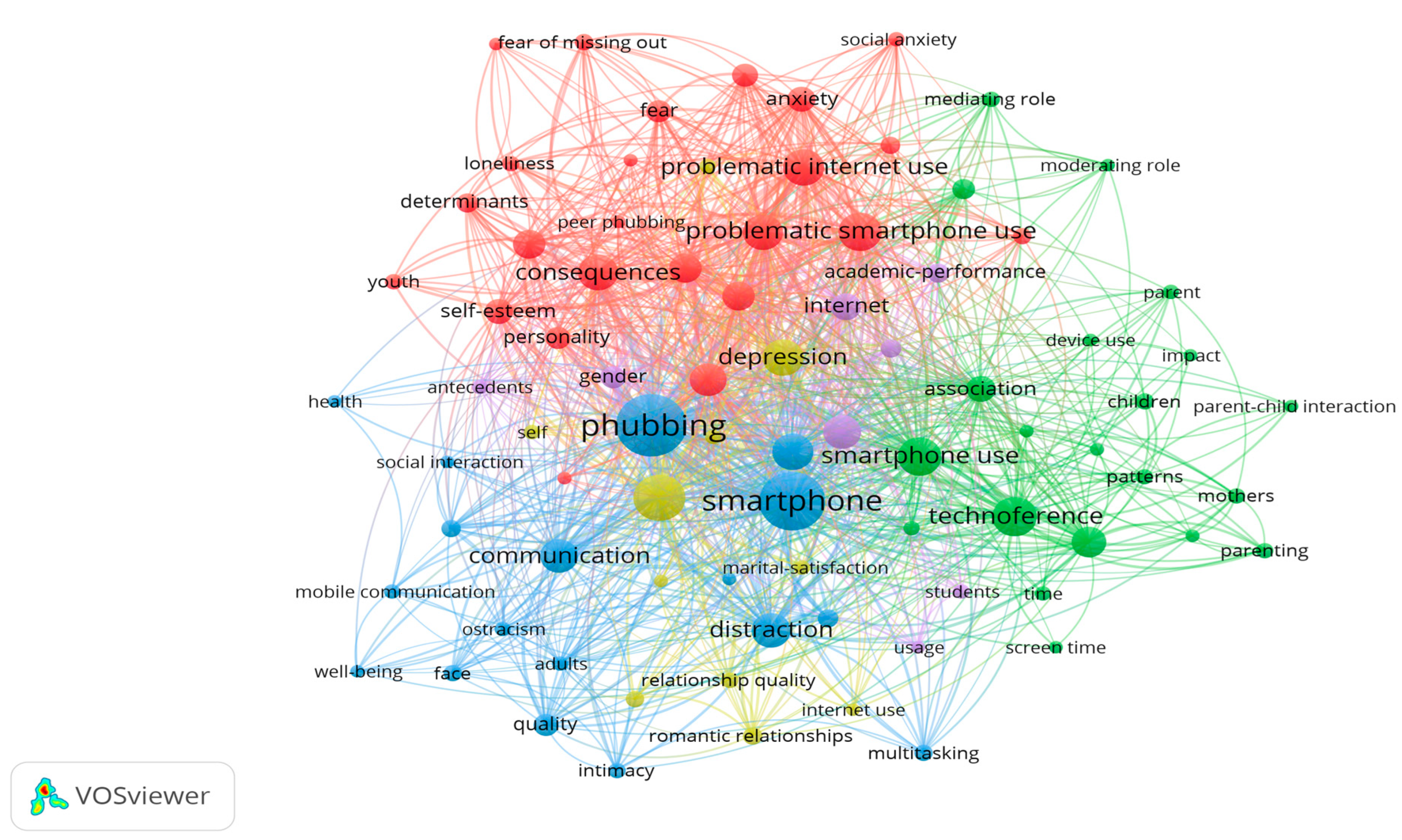

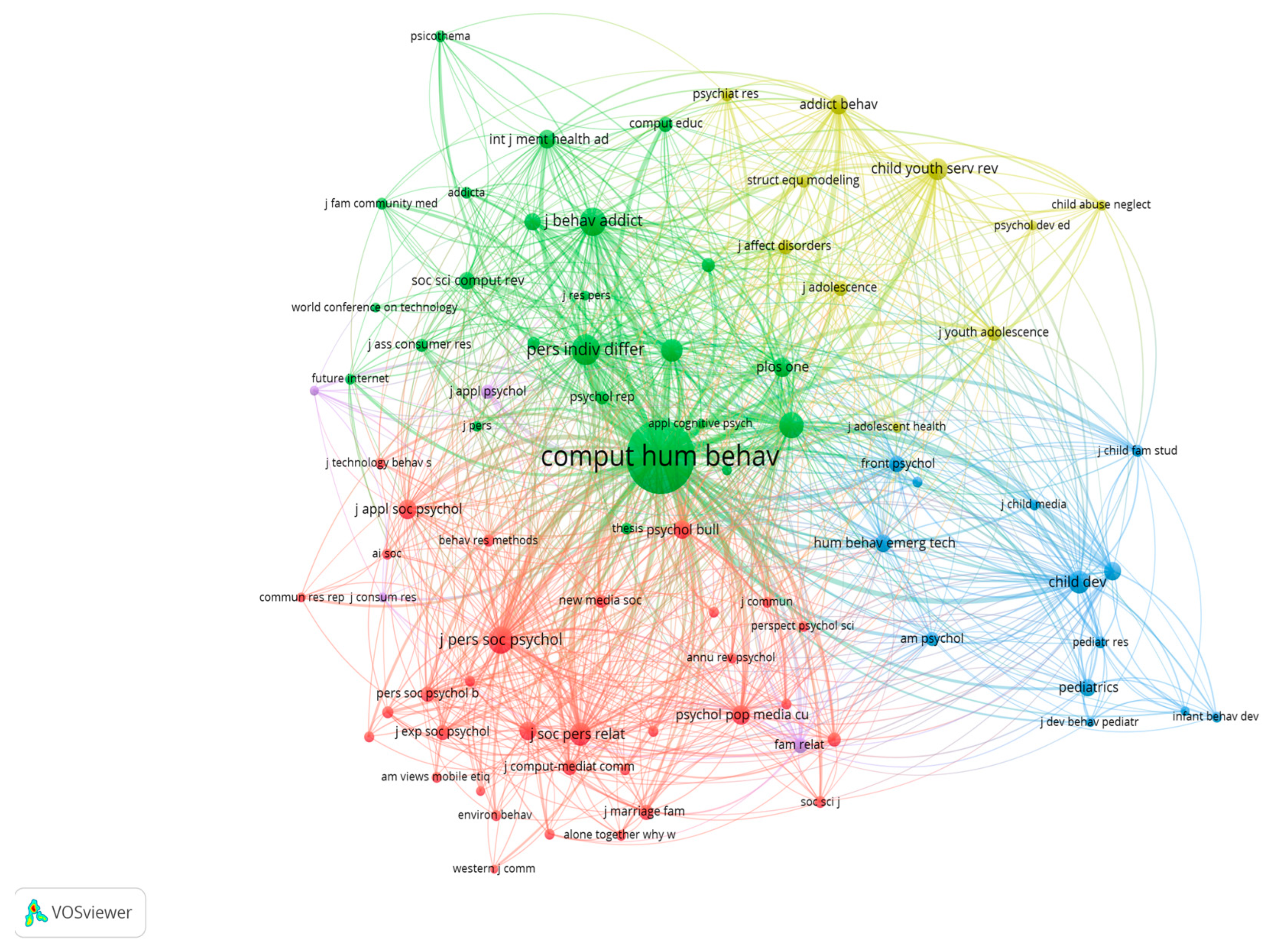
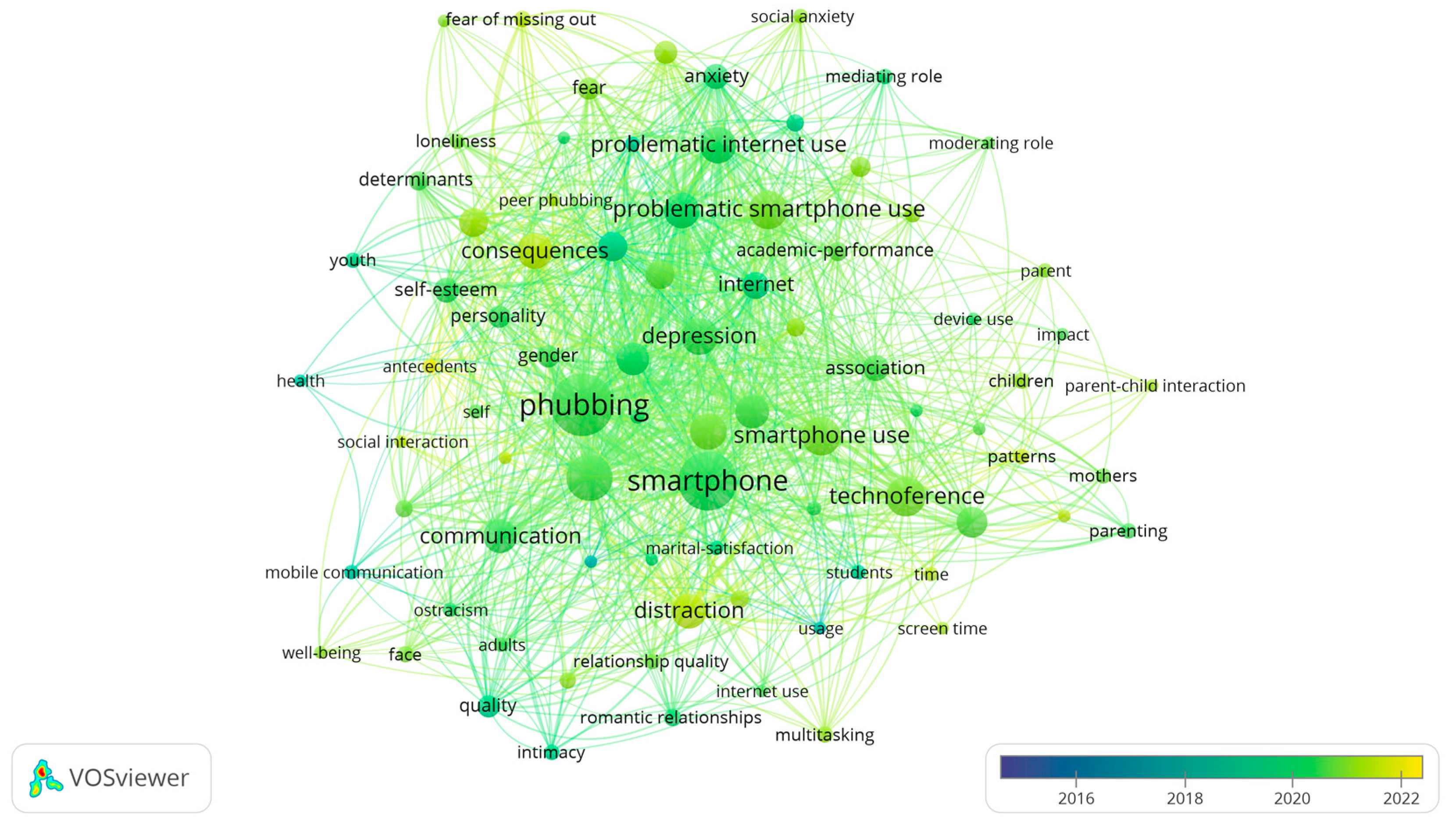
| Title | Authors | Journal | Year | Citations | Normalised Number of Citations |
|---|---|---|---|---|---|
| My life has become a major distraction from my cell phone: partner phubbing and relationship satisfaction among romantic partners | Roberts, J.A. and David, M.E. | Computers in Human Behavior 54, 134–141 | 2016 | 260 | 2.2414 |
| How “phubbing” becomes the norm: the antecedents and consequences of snubbing via smartphone | Chotpitayasunondh, V and Douglas, K. M. | Computers in Human Behavior 63, 9–18 | 2016 | 251 | 2.1638 |
| Determinants of phubbing, which is the sum of many virtual addictions: a structural equation model. | Karadag, Engin; Tosuntas, Sule Betul; Erzen, Evren; Duru, Pinar; Bostan, Nalan; Sahin, Berrak Mizrak; Culha, Ilkay; Babadag, Burcu | Journal of Behavioral Addictions 4(2), 60–74. | 2015 | 124 | 1.5215 |
| “Technoference”: the interference of technology in couple relationships and implications for women’s personal and relational well-being. | McDaniel, B.T. and Coyne, S.M. | Psychology of Popular Media Culture 5(1), 85–98 | 2016 | 115 | 0.9914 |
| The effects of “phubbing” on social interaction | Chotpitayasunondh, V. and Douglas, K.M. | Journal of Applied Social Psychology 48(6), 304–316 | 2018 | 108 | 2.5389 |
| Name | Documents | Citations | Normalised Number of Citations | Name | Documents | Citations | Normalised Number of Citations |
|---|---|---|---|---|---|---|---|
| Chotpitayasunondh, Varoth | 3 | 404 | 5.7605 | Vanden Abeele, Mariek | 6 | 282 | 6.6417 |
| Douglas, Karen | 3 | 404 | 5.7605 | Coyne, Sarah | 4 | 198 | 3.6488 |
| David, Meredith | 6 | 352 | 8.1217 | Erzen, Evren | 4 | 174 | 7.6142 |
| Roberts, James | 6 | 352 | 8.1217 | Babadag, Burcu | 2 | 156 | 1.7973 |
| McDaniel, Brandon | 9 | 326 | 16.5326 | Bostan, Nalan | 2 | 156 | 1.7973 |
| Journal | Documents | Citations | Normalized Number of Citations |
|---|---|---|---|
| Computers in Human Behavior | 20 | 1081 | 27.29 |
| Children and Youth Services Review | 7 | 150 | 9.6178 |
| Current Psychology | 7 | 29 | 5.8319 |
| Mobile Media & Communication | 7 | 74 | 5.8831 |
| Human Behavior and Emerging Technologies | 6 | 129 | 9.7033 |
| International Journal of Environmental Research and Public Health | 6 | 97 | 2.6854 |
| Frontiers in Psychology | 5 | 28 | 4.6814 |
| Country | Documents | Citations | Links | Country | Documents | Citations | Links |
|---|---|---|---|---|---|---|---|
| USA | 58 | 1151 | 16 | Netherlands | 11 | 351 | 16 |
| People’s R China | 46 | 420 | 16 | Germany | 10 | 48 | 16 |
| Turkey | 19 | 325 | 16 | Australia | 9 | 119 | 16 |
| Spain | 15 | 49 | 15 | Italy | 8 | 152 | 15 |
| England | 13 | 503 | 16 | Poland | 7 | 133 | 16 |
| Institution | Documents | Citations | Links | Institution | Documents | Citations | Links |
|---|---|---|---|---|---|---|---|
| Renmin University of China | 12 | 144 | 8 | Ghent University (Belgium) | 6 | 194 | 8 |
| Tilburg University (Netherlands) | 8 | 304 | 10 | Northeast Normal University (China) | 6 | 125 | 9 |
| Illinois State University (USA) | 8 | 225 | 9 | University of Malaga (Spain) | 6 | 28 | 4 |
| Shanxi University (China) | 8 | 101 | 8 | Beijing Normal University (China) | 5 | 68 | 8 |
| Baylor University (USA) | 6 | 352 | 10 | Central China Normal University | 5 | 55 | 7 |
Disclaimer/Publisher’s Note: The statements, opinions and data contained in all publications are solely those of the individual author(s) and contributor(s) and not of MDPI and/or the editor(s). MDPI and/or the editor(s) disclaim responsibility for any injury to people or property resulting from any ideas, methods, instructions or products referred to in the content. |
© 2025 by the authors. Licensee MDPI, Basel, Switzerland. This article is an open access article distributed under the terms and conditions of the Creative Commons Attribution (CC BY) license (https://creativecommons.org/licenses/by/4.0/).
Share and Cite
Cebollero-Salinas, A.; Gutiérrez-Nieto, B.; Cano-Escoriaza, J. Phubbing Behaviour: A Bibliometric Analysis of Scientific Production. Behav. Sci. 2025, 15, 745. https://doi.org/10.3390/bs15060745
Cebollero-Salinas A, Gutiérrez-Nieto B, Cano-Escoriaza J. Phubbing Behaviour: A Bibliometric Analysis of Scientific Production. Behavioral Sciences. 2025; 15(6):745. https://doi.org/10.3390/bs15060745
Chicago/Turabian StyleCebollero-Salinas, Ana, Begoña Gutiérrez-Nieto, and Jacobo Cano-Escoriaza. 2025. "Phubbing Behaviour: A Bibliometric Analysis of Scientific Production" Behavioral Sciences 15, no. 6: 745. https://doi.org/10.3390/bs15060745
APA StyleCebollero-Salinas, A., Gutiérrez-Nieto, B., & Cano-Escoriaza, J. (2025). Phubbing Behaviour: A Bibliometric Analysis of Scientific Production. Behavioral Sciences, 15(6), 745. https://doi.org/10.3390/bs15060745






